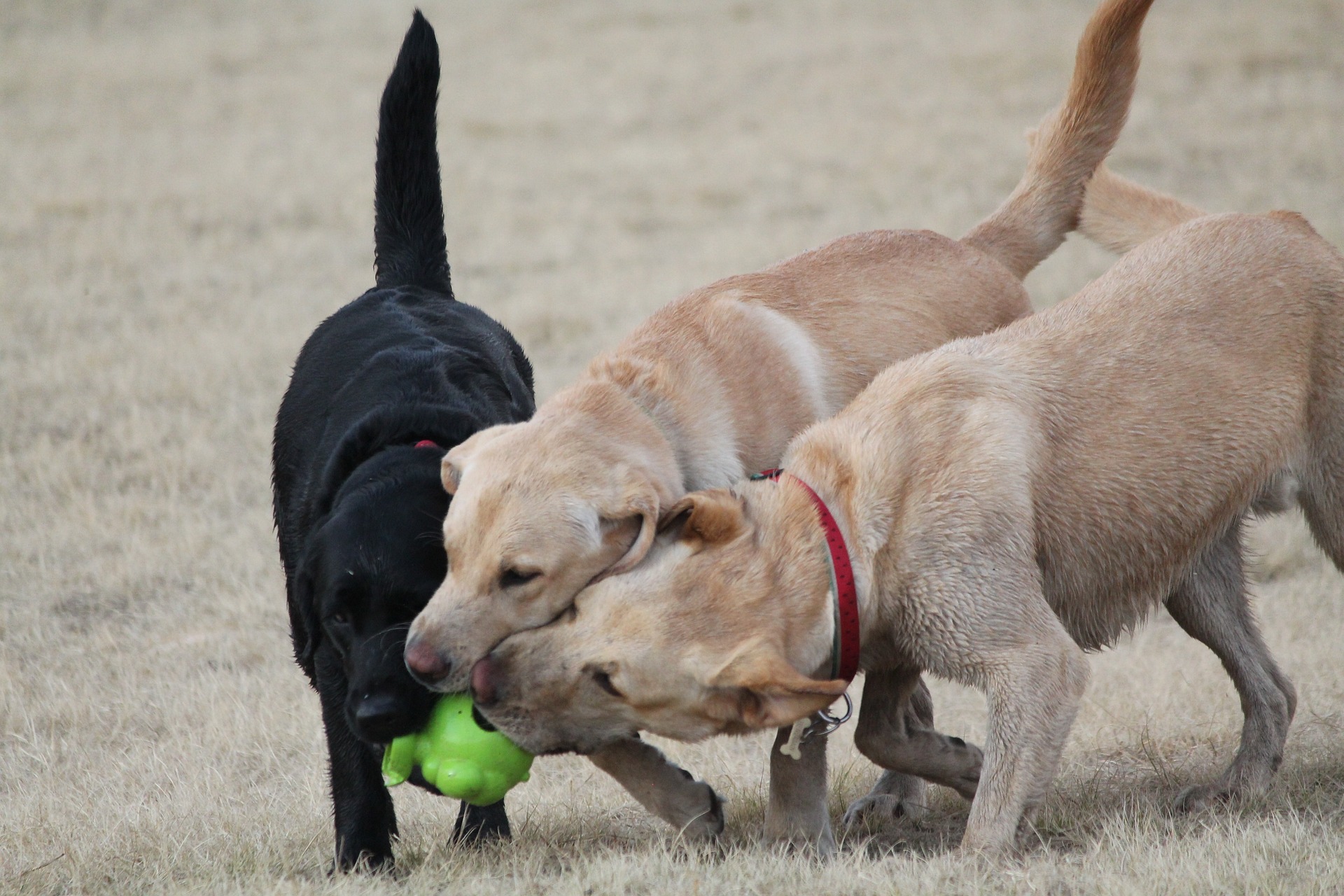What To Know About Labrador Retrievers
Do you have your heart set on adding a Labrador Retriever to your family? Are you trying to learn all that you can about this breed? Or perhaps you already have one and want to know more.
The Labrador Retriever is a popular pet but has a strong working history. Also, many modern-day Labrador Retrievers kept as pets are also actively employed as sporting dogs.
The Labrador Retriever is an energetic and active dog that loves to run and play. They are loving, gentle, loyal, friendly, and highly trainable. Their intelligence makes them great candidates for any type of training.
In this article, we will go over everything you need to know about Labrador Retrievers. We will discuss their origins, temperament, physical characteristics, and more.
Origins
Although their name could lead one to believe they originated in Labrador, Canada, Labrador Retrievers were developed in Newfoundland in the 1500s. A breed known as the St. John’s Water Dog or Lesser Newfoundland was developed by crossing small water dogs with Newfoundlands.
These dogs, who belonged to fishermen, jumped into the icy water to retrieve fish that had slipped the hooks. They would also draw in nets with fish in them. The breed was ideal for these jobs because of its water-repellent coat and good swimming abilities due to its webbed paws.
Until the early 1800s, when they were transported to Poole, England, the dogs remained confined to Newfoundland. After witnessing the breed in action, the Earl of Malmesbury brought them home right away. The Earl and Duke of Malmesbury utilized them in shooting competitions and started referring to them as their “Labrador Dogs.” The English Kennel Club approved labradors in 1903.
The popularity of the breed started to rise. As American farmers and hunters became aware of the breed’s work ethic in the early 1900s, they started integrating “Labs” into their everyday routines. In 1917, the American Kennel Club recognized Labrador Retrievers, and many families adopted the breed as a devoted companion.
Even today, Labrador Retrievers are eager to please their pet owners and go to work. Additionally, they are friendly, energetic, bright, and nice to people, especially kids and other animals. Although they don’t require much grooming, they require a lot of daily exercise. They enjoy taking regular, strenuous walks, playing fetch, or even swimming in a secure environment. The AKC usually ranks them first among the most popular breeds.
Temperament
The Labrador Retriever is an ideal family pet. They are loyal and devoted to their owners, get along very well with other pets in the house, and love interacting with children of all ages. Moreover, they are good-natured and friendly towards people, even strangers, but can be assertive if needed.
They are also highly intelligent, which makes them easy to train. Labs can learn to follow commands quickly and respond to their pet parent’s voice without hesitation.
They possess a strong work ethic and can be taught almost anything with the right amount of patience and consistency. Additionally, they have great endurance, making them perfect for outdoor activities and adventurous trips.
Physical Characteristics
The Labrador Retriever is a medium-sized dog with a muscular body. The breed has a double coat with a thick outer layer of fur that keeps them well-insulated in the cold winter months. Depending on their genetic makeup, they can come in black, yellow, or chocolate colors.
They usually weigh between 55 and 80 pounds, with males significantly bigger than females. With proper nutrition, exercise, and grooming, these dogs can live up to 10-12 years.
Care
The adoring Lab must be near their family and is not a backyard dog. A lonely, bored Lab is likely to dig, gnaw, or find other destructive outlets for its energy, thereby ruining the dog’s otherwise impeccable reputation.
Although there is some diversity in the activity levels of labs, it is clear that all of them require regular exercise and mental stimulation. Taking your Lab on daily 30-minute walks, taking him to the dog park for some playtime, or playing fetch are all great methods to get rid of excess energy.
A puppy, however, should only be taken on short walks and given short bursts of playtime. It’s well known that Labrador Retrievers are “workaholics” who constantly push themselves to the limit. It is up to you to decide when to stop playing and training.
Because of their generally positive image, some dog owners may assume that their Labrador retrievers don’t require special instruction. That’s a terrible idea. A hyperactive Lab puppy will mature into a huge, unruly dog if not properly trained.
Fortunately, Labs respond positively to instruction; in fact, they frequently place highly in obedience competitions. It is important to socialize with your Lab early on, as this will prepare them for new environments and unfamiliar people.
When it comes to grooming, Labs need high-quality food, regular brushing, and occasional baths. Brushing their coats weekly will help keep their fur clean and tangle-free. Bathing should be done only when necessary, as over-bathing can strip the natural oils from their coat.
Feeding
The recommended meals for an adult Labrador Retriever should consist of two to three cups of high-quality dry food per day, split into two meals. Puppies may require up to four meals daily as they grow.
Be aware that the amount of food your adult dog needs depends on factors such as age, size, structure, metabolism, and level of exercise. Like humans, dogs are unique in their nutritional requirements. A hyperactive dog will require more food than a less active dog.
No matter the breed, all dogs should have access to clean, fresh water. There are many great dog foods on the market; however, it’s always smart to consult a veterinary professional before selecting food for your puppy. Labrador Retrievers need a balanced diet that includes proteins, carbohydrates, fats, vitamins, and minerals.
Health Problems
Labrador retrievers are among the most popular breeds of dogs in the United States. They are known for their loyalty, intelligence, and trainability. However, like all breeds of dogs, they are also susceptible to certain health problems. Some of the more common health problems seen in Labrador retrievers include:
🐕 Hip and Elbow Dysplasia
Hip and elbow dysplasia are common orthopedic problems in Labrador Retrievers. Both conditions are caused by abnormal hip or elbow joint development, leading to pain and arthritis.
Hip dysplasia is more common in Labrador Retrievers than any other breed, and elbow dysplasia is also relatively common. The best way to prevent these conditions is to have your dog’s hips and elbows checked by a veterinarian before breeding.
If you are considering getting a Labrador Retriever, be sure to ask the breeder about the health of the parents’ hips and elbows. You can also ask your veterinarian to perform x-rays on your dog’s hips and elbows to check for dysplasia. Treatment for hip and elbow dysplasia typically involves surgery to correct the problem.
In some cases, joint supplements or pain medication may also be necessary. With proper treatment, most dogs with hip or elbow dysplasia can lead happy, healthy lives.
🐕 Obesity
Obesity is a major health problem in Labrador Retrievers. It is estimated that over 50% of Labradors are overweight or obese. Obesity can lead to several serious health problems, including diabetes, joint problems, and heart disease.
In addition, obese dogs are more likely to be put down by their owners than dogs of healthy weight. As a result, all Labrador owners need to ensure that their dog remains at a healthy weight. The best way to do this is to feed them a high-quality diet and make sure they get plenty of exercise.
🐕 Bloat
Bloat is a life-threatening condition that can occur in any large breed dog, including the Labrador Retriever. It occurs when gas builds up in the stomach and causes it to twist. This prevents blood from reaching vital organs, leading to shock and even death if not treated immediately.
The best way to prevent bloat is to feed your dog several small meals a day instead of one large meal and avoid exercising immediately after eating.
🐕 Allergies
Allergies are another common health problem in Labrador Retrievers. These allergies can be caused by food, environmental allergens, or fleas and ticks. Symptoms of allergies include scratching, skin irritation, hair loss, and recurrent ear infections.
If you suspect your dog has allergies, talk to your veterinarian right away, as they may need to be put on a special diet or medication.
🐕 Epilepsy
Epilepsy is not common in Labrador Retrievers but does occur. Epilepsy is a neurological disorder that can cause seizures. Seizures can vary in severity, from mild episodes that last a few seconds to severe episodes that last for several minutes.
Epilepsy can be diagnosed by a veterinarian using a variety of tests, including blood tests, brain scans, and electrical activity recordings. While there is no cure for epilepsy, you can manage it with medication and lifestyle changes.
🐕 Tricuspid Valve Dysplasia (TVD)
Tricuspid valve dysplasia is a rare congenital heart defect that affects some Labrador Retrievers. The tricuspid valve, located between the right atrium and ventricle of the heart, does not function properly in dogs with TVD. If left untreated, this can lead to an irregular heartbeat, difficulty breathing, and even organ failure.
To diagnose TVD, your veterinarian may need to use an ultrasound or echocardiogram. Treatment typically involves medications and surgery to correct the defect. With proper treatment and management, most dogs with TVD can lead healthy lives.
🐕 Myopathy
Muscle and nerve dysfunction characterize myopathy. The earliest warning signals may appear as early as six weeks of life but usually appear between seven and nine months. When a puppy suffers from myopathy, he becomes tired and stiff when moving.
He might pass out after working out. When a dog’s muscles atrophy, it cannot even stand up. There is currently no cure, but rest and warmth seem to help. Because of the potential for the disease to be passed on through offspring, myopathic dogs should not be bred.
🐕 Ear Infection
Ear infections are among the most common health problems in Labrador Retrievers, especially those with floppy ears. Ear infections occur when bacteria and yeast build up in the ear canal, leading to inflammation and discomfort. Symptoms include head shaking, scratching at the ear, redness or discharge from the ear, and an unpleasant odor coming from the ear.
You can treat ear infections with antibiotics prescribed by your veterinarian. It is important to keep your Labrador’s ears clean and dry to help prevent ear infections.
Labrador Retrievers are a beloved breed of dog, but like all dogs, they are prone to certain health issues. Knowing what conditions Labradors may face is the first step in ensuring their healthy, happy lives. With regular veterinary care, proper nutrition, and exercise, Labrador Retrievers can live long, healthy lives.
The Advantages and Disadvantages of Owning a Labrador Retriever
There’s no denying the Labrador’s beauty, but like other breeds, they have flaws.
✅ Advantages
As a result of their high level of intellect, they respond well to contemporary positive training techniques, and their insatiable appetites make them easy to inspire. All the most prevalent health issues in Labradors can be avoided or at least mitigated with the help of health tests.
They have a warm disposition and get along well with other dogs and humans. In addition, they tend to get along well with cats if they are exposed to them at a young age or raised with them. They’ll adore you irrevocably and seek your presence often.
❎ Disadvantages
Labradors are high-energy dogs who require a lot of activity, though not too much while they are young, to protect their developing joints. Because of the risk of genetic diseases, you should only choose a puppy from a breeder who has thoroughly checked the health of both parents.
You’ll have to put in a lot of time and effort to train them, so they don’t jump on people or tug on the leash, and you’ll also have to work hard to keep your home free of fur. When you leave the house, they will likely want to meet and welcome everyone they see, including any dogs they may encounter. In addition, they may suffer from separation anxiety.
Labrador Retriever Training Tips
Labrador Retrievers are known for their intelligence and trainability. However, it is important to remember that training should be consistent, firm, fair, and positive. Here are some tips to help you train your Lab:
✅Start Early
Socialize your Labrador Retriever puppy as soon as possible. This will help him become more comfortable around people and other animals.
✅Use Positive Reinforcement
Positive reinforcement training is the most effective way to train a Lab. This means rewarding desired behaviors with treats, praise, and attention.
✅Make it Fun
Training should be an enjoyable experience for you and your dog. Keep training sessions short and ensure they are a positive experience for your Lab.
✅Be Consistent
When it comes to training, consistency is key. You must use the same commands, rewards, and punishments each time you train your Labrador Retriever.
✅Remain Patient
Training can be a long process. It is important to remain patient and consistent throughout the training period.
✅Seek Help
If you are having difficulty training your Labrador Retriever, seek the help of a professional dog trainer. A professional can provide personalized advice to help you achieve success with your Lab.
In addition to training, it is important to keep up with regular veterinary checkups and provide high-quality nutrition. Labrador Retrievers have unique needs you must meet for them to live long and healthy lives. With the right kind of care, love, and attention, your Lab can be a joyful companion for many years to come.
By following these tips, you will be well on your way to having a happy and well-trained Lab. With consistency and patience, you can help your Labrador Retriever become a beloved, well-behaved member of the family!
Frequently Asked Questions
Q: How long does it take to train a Labrador Retriever?
A: The amount of time it takes to train a Labrador Retriever depends on the individual dog and the level of training they need. However, most dogs can learn basic obedience commands in 1-2 months with consistent training and positive reinforcement.
Q: How can I find a good Labrador Retriever breeder?
A: The best way to find a reputable Labrador Retriever breeder is by researching breeders in your area and asking for recommendations from other dog owners. It would be best to ask the breeder questions about their breeding practices and health testing policies to ensure they are responsible.
Q: What is the best way to exercise my Labrador Retriever?
A: The best way to exercise your Labrador Retriever is through physical activity and mental stimulation. Labs need plenty of playtimes, walks, runs, and other activities to keep them mentally and physically engaged. It is also important to give your Lab plenty of time to rest and relax after exercise.
Q: Does a Labrador Retriever need grooming?
A: Yes. A Labrador Retriever needs regular grooming to keep its coat healthy and free of tangles and mats. Grooming sessions should include brushing, bathing, nail trimming, ear cleaning, and other necessary maintenance. Additionally, Labs may require professional grooming services such as clipping or scissoring every few months.
Q: How can I keep my Labrador Retriever healthy?
A: The best way to keep your Labrador Retriever healthy is by providing them with high-quality nutrition and regular veterinary checkups. It is also important to provide plenty of exercises, mental stimulation, and socialization opportunities for your Lab. Furthermore, it is important to brush their teeth, clean their ears and keep them up-to-date on flea and tick preventative.
Final Words
Labradors are beautiful, loyal companions whose intelligence and friendly nature make them wonderful dogs to own. With responsible ownership and proper training, they can become well-behaved family members who bring joy to everyone in the home. If you are thinking about adding a Labrador Retriever to your family, make sure to do your research and choose a healthy puppy from a reputable breeder.











